COOPERATION MODEL
ARTIFICIAL INTELLIGENCE
PRODUCT ENGINEERING
DevOps & Cloud
LOW-CODE/NO-CODE DEVELOPMENT
INDUSTRY
FRONTEND DEVELOPMENT
CLOUD DEVELOPMENT
MOBILE APP DEVELOPMENT
LOW CODE/ NO CODE DEVELOPMENT
EMERGING TECHNOLOGIES







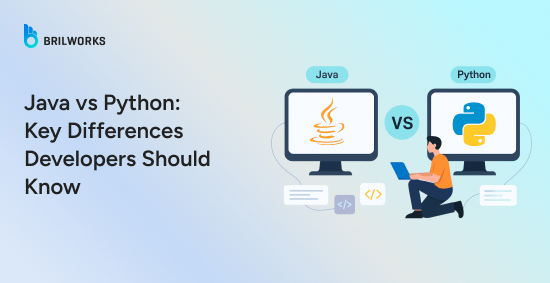
Java vs Python is a common comparison among developers choosing the right tool for backend systems, automation, or full-stack development. These are two of the most widely used programming languages in modern software development. Both are stable, well-supported, and have stood the test of time. They offer different strengths depending on the kind of work you're doing.
Java is known for its performance, structure, and strong presence in enterprise systems. It’s often used in large-scale applications, banking systems, and backend-heavy platforms where reliability and long-term maintainability matter. Python is more flexible and often favored for scripting, automation, and fast development. It plays a major role in data science, machine learning, and applications where quick iteration is useful.
This blog is for developers who already know the basics and want a clear technical comparison. It looks at how each language performs in real projects, how its ecosystems have evolved, and where they make the most sense depending on the use case.
Java vs Python are often compared because they show up in similar places, even though they take very different approaches. Both are general-purpose, high-level languages with large ecosystems and strong community support. Developers use them for backend services, web development, automation, and more.
The reason this comparison still matters is that the trade-offs between the two have become more defined over time. Java has continued to evolve in the enterprise space, with strong performance and tools built for large, long-running systems. Python has become the go-to for areas like data analysis, scripting, and machine learning, where speed of development and flexibility are more important than raw performance.
Many teams today are choosing between these two for new projects, especially when working across web, cloud, or data-driven platforms. Understanding where each language fits helps avoid mismatched tooling and unexpected limits later on. This blog breaks that down with a technical lens, without oversimplifying the real differences.
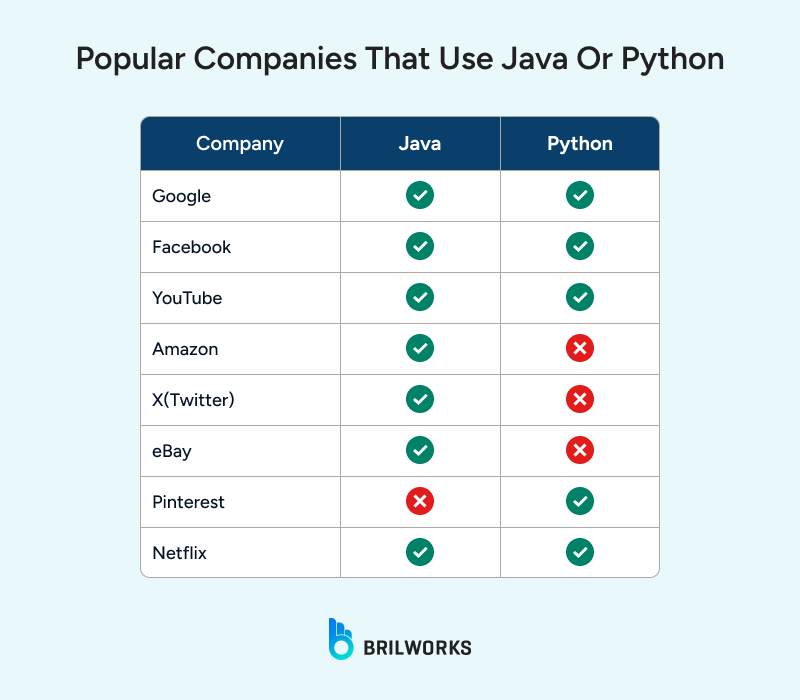
(source: Wikipedia)
As we can see, many big companies around the globe are utilizing Java on their backend side. While companies like Google, Facebook, and YouTube leverage both Java and Python on the server side.
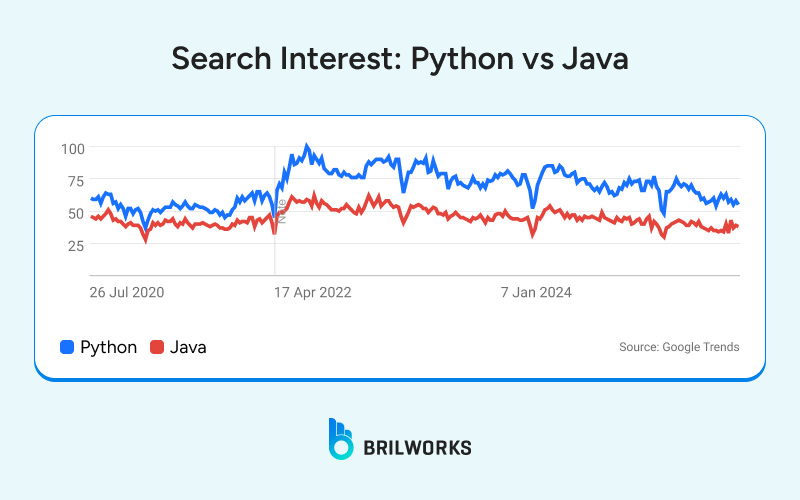
According to Google Trends, Python has shown more interest over time than Java in the past five years. This shift highlights the difference between Java and Python in terms of how each language is being adopted across domains. Python continues to gain attention, especially in scripting and data-driven development.
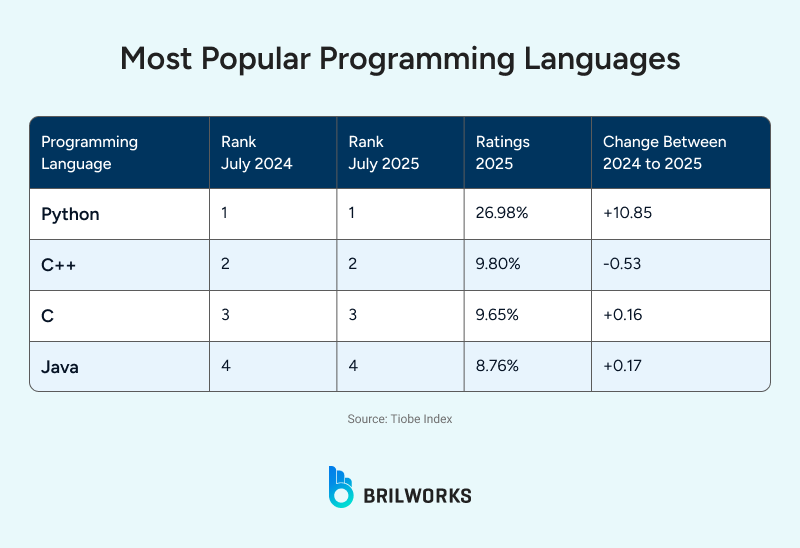
The TIOBE Index currently ranks Python as the most popular programming language. Java comes in at fourth. These rankings are based on factors like search engine traffic, developer activity, and community engagement.
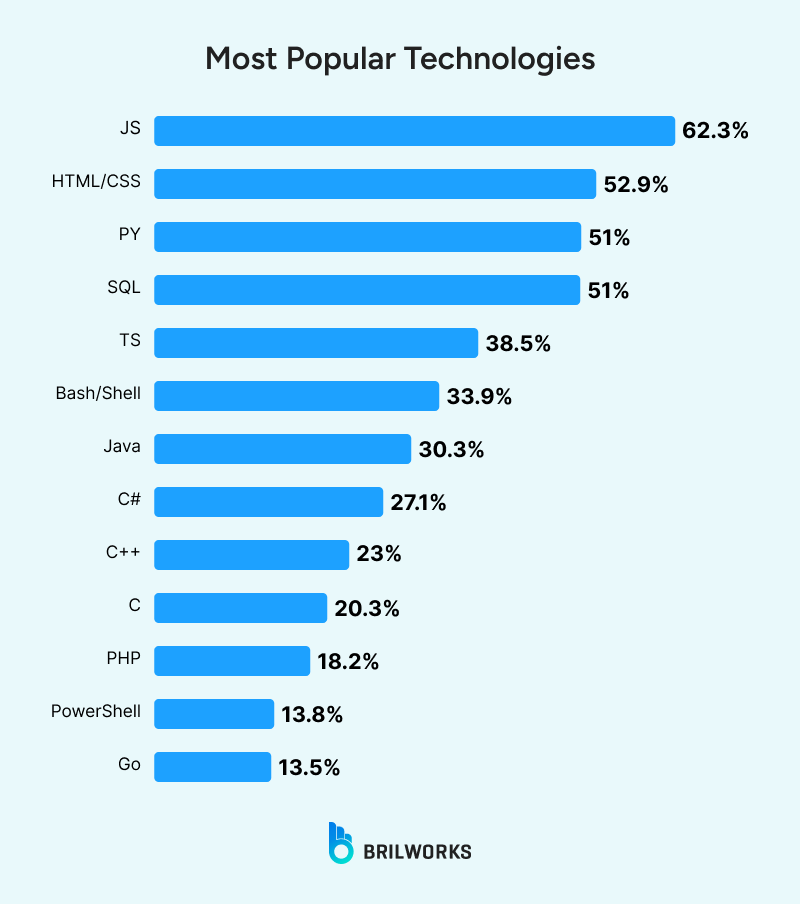
As per the Stack Overflow Developer Survey 2024, Python holds a higher position than Java among the most commonly used languages by developers. This includes both professional and hobbyist developers across different industries.
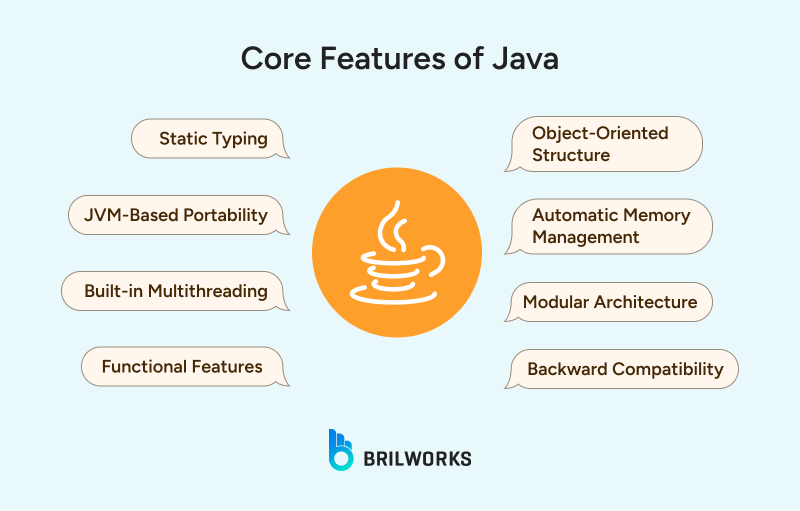
Java has been around since the mid-90s and continues to power a wide range of software systems today. Known for its performance, type safety, and strong tooling, it remains a popular choice for enterprise-scale development. This section breaks down how Java has evolved, how it performs in production, and what its ecosystem looks like today.
Released in 1995, Java has come a long way in the last three decades. Java has seen steady updates in recent years aimed at improving readability and reducing boilerplate. Features like records, switch expressions, text blocks, sealed classes, and pattern matching have added more flexibility without straying far from the core design of the language. The faster release cycle, with updates every six months, gives developers access to newer features sooner, while long-term support versions remain stable for enterprise use.
Java is built for performance in production environments. The JVM allows for runtime optimizations through just-in-time compilation and offers different garbage collection options based on workload needs. Developers can fine-tune memory usage, thread behavior, and garbage collection strategies to get consistent performance under load. These tuning capabilities make Java reliable for high-throughput systems and long-running services.
Java’s ecosystem is mature and well-supported. Build tools like Maven and Gradle are standard in most projects. IDEs such as IntelliJ IDEA and Eclipse offer strong language support and deep integration with frameworks. Spring remains the most widely used framework in Java development, especially for backend and enterprise systems. Java frameworks like Micronaut and Quarkus are gaining traction for cloud-native development with faster startup times and lower resource usage.
Static Typing - Java uses static typing, which helps catch errors at compile time and improves code reliability in large systems.
Object-Oriented Structure - The language is built around classes and objects, encouraging modular code and reuse across projects.
JVM-Based Portability - Java runs on the Java Virtual Machine, making it easy to deploy the same code across different platforms without modification.
Automatic Memory Management - Java handles memory through garbage collection, reducing the chances of memory leaks in long-running applications.
Built-in Multithreading - It includes native support for multithreading, allowing better use of system resources in concurrent applications.
Modular Architecture - Since Java 9, the module system allows developers to better manage dependencies and create more maintainable codebases.
Functional Features - Modern Java versions support lambdas, method references, and streams, enabling a more concise and expressive coding style.
Backward Compatibility - Code written in older versions usually runs on newer versions with minimal changes, which is useful in long-term projects.
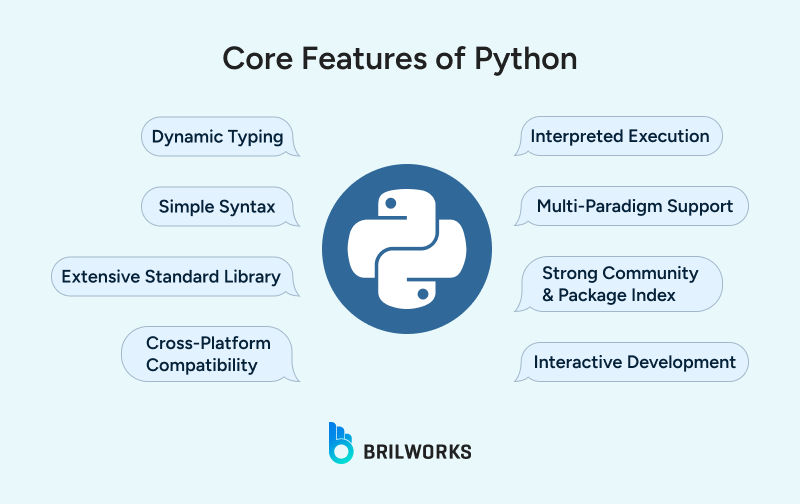
Python is known for its simplicity and versatility. It has grown from a scripting language into a key player in areas like data science, automation, and web development. This section looks at how Python has developed over time, how it performs in different environments, and what tools and frameworks support it today.
Python has remained focused on simplicity and readability while gradually adding new features. Recent versions have introduced structural pattern matching, assignment expressions, and better typing support through type hints. These updates aim to make the language more suitable for larger codebases without losing its beginner-friendly nature. The community continues to drive changes through Python Enhancement Proposals, keeping the language active without breaking older code.
Python is not designed for raw performance, especially compared to compiled languages. It runs slower due to its interpreted nature and the global interpreter lock, which limits concurrent execution in multi-threaded programs. That said, performance bottlenecks are often handled by integrating native extensions written in C or by using alternative runtimes like PyPy. For CPU-heavy tasks, Python is usually paired with optimized libraries rather than used alone.
Python’s ecosystem is broad and covers everything from web development to machine learning. Frameworks like Flask and Django are widely used for building web applications. In data and scientific computing, libraries like NumPy, pandas, and TensorFlow dominate. Package management through pip is simple, and tools like Poetry and virtualenv help manage dependencies and environments. IDEs such as VS Code and PyCharm offer strong support for Python development across different domains.
Dynamic Typing - Python uses dynamic typing, which makes it flexible and quick to write, especially during early development stages.
Interpreted Execution - Python runs directly from source code using an interpreter, allowing for faster testing and iteration without compilation steps.
Simple Syntax - The syntax is clean and readable, which helps reduce the time needed to write and maintain code.
Multi-Paradigm Support - Python supports procedural, object-oriented, and functional programming styles, giving developers different ways to structure their code.
Extensive Standard Library - It comes with a wide range of built-in modules for tasks like file handling, networking, regular expressions, and more.
Strong Community and Package Index - The Python Package Index (PyPI) offers thousands of third-party libraries for everything from web frameworks to machine learning.
Cross-Platform Compatibility - Python code runs on major platforms with little to no modification, making it a solid choice for cross-platform tools.
Interactive Development- Tools like the Python REPL and Jupyter notebooks support interactive coding, which is helpful in data science and scripting workflows.
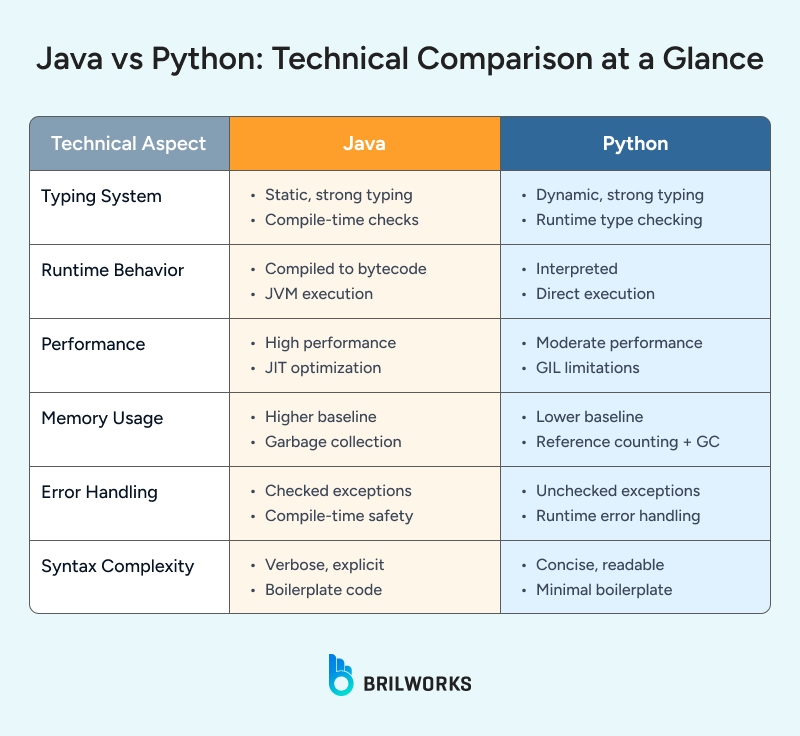
Java vs Python comes down to core design choices, which affect how they perform and how developers interact with them in real projects. These differences show up in typing systems, runtime behavior, error handling, and how the languages are used in production.
Java uses static typing. All variables must have a defined type at compile time, which helps catch type-related bugs early and enforces more structure in large codebases. Python uses dynamic typing, so variable types are resolved at runtime. This allows for faster development and simpler syntax, but can lead to runtime errors if types are not handled carefully.
Java is compiled to bytecode and runs on the Java Virtual Machine. This setup allows for optimizations like just-in-time compilation, which can improve performance over time. Python is interpreted, meaning the code is executed line by line. This makes it easier to test and debug, but generally results in slower performance for CPU-bound tasks.
Java tends to offer better raw performance in most scenarios, especially for backend systems and compute-intensive tasks. The JVM can optimize execution over time, and the language is better suited for multi-threaded workloads. Python is slower by comparison due to the interpreter and the global interpreter lock, which limits parallel execution in threads. Many performance-heavy Python applications rely on external libraries written in C to offset this limitation.
Both languages offer automatic memory management. Java uses garbage collection with multiple tuning options depending on the use case. Developers can control heap size, garbage collector behavior, and other memory-related settings. Python relies on reference counting combined with a cyclic garbage collector. It requires less configuration but offers less control, especially in long-running processes where memory leaks can be harder to detect.
Java enforces checked exceptions, requiring developers to explicitly declare or handle certain errors. This makes error handling more predictable and visible in the code. Python uses an untyped exception model with try-except blocks, allowing more flexibility but less enforced discipline in how errors are handled.
Java projects often use build tools like Maven or Gradle to manage dependencies, compile code, run tests, and package applications. These tools enforce a structured build lifecycle. Python uses simpler tools like pip for dependency management and virtualenv or Poetry for environment isolation. While setup is usually faster, it can become inconsistent across environments without proper controls.
Java applications typically run with a larger memory footprint and longer startup time, but they offer more predictable performance once initialized. Python starts quickly and uses less memory up front, which makes it suitable for scripts, automation, and short-lived services. However, its long-term performance may vary more depending on workload and usage patterns. Java’s strict runtime behavior and compile-time checks can lead to fewer surprises in production and better practices around Java security.
Also read: Java vs C++
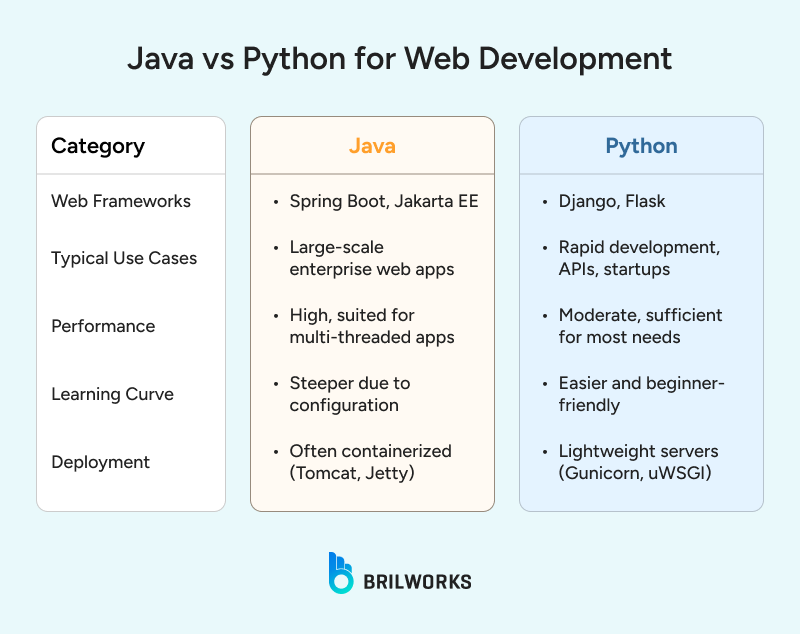
Java web development is typically centered around full-featured frameworks like Spring and Jakarta EE. These frameworks emphasize layered architecture, strong typing, and enterprise-grade capabilities like transaction management, security, and dependency injection. Configuration is often handled through annotations or XML, and projects follow structured build processes using tools like Maven or Gradle.
// Spring Boot route example
@GetMapping("/hello")
public String hello() {
return "Hello, World!";
}Python offers a simpler and more flexible approach. Django is a full-stack framework that includes an ORM, templating engine, and admin interface. Flask is minimal and gives developers more control over how components are wired together. Python frameworks focus on reducing boilerplate and speeding up development.
# Flask route example
@app.route("/hello")
def hello():
return "Hello, World!"Java applications generally perform better under load. The JVM can optimize execution with just-in-time compilation, and Java handles multithreading more efficiently. This makes it a solid choice for high-concurrency environments like financial services or real-time APIs.
Python’s performance is lower by default due to its interpreted nature and the global interpreter lock. For most web applications, this isn’t a problem, especially when using asynchronous frameworks or caching layers. However, Python may require extra care or offloading of compute-heavy tasks for larger-scale systems.
Java projects often use Gradle or Maven to manage builds, testing, and packaging. These tools enforce a clear lifecycle and help standardize large projects. Java developers rely heavily on IDEs like IntelliJ IDEA, which offer deep integration with frameworks and static analysis.
Python uses simpler tooling. Projects are usually managed through pip and virtual environments. Poetry and pipenv offer more structure for dependency management, but many small to mid-sized Python projects don’t require a full build pipeline. Editors like VS Code or PyCharm offer good support, but the setup is typically lighter than in Java.
Java applications are often packaged as JARs or WARs and deployed in containers or managed cloud environments. They may have longer startup times and a larger memory footprint, but they offer more consistent runtime behavior and better tuning options.
Python apps are quicker to spin up and usually run through WSGI or ASGI servers like Gunicorn, uWSGI, or uvicorn. Virtual environments help isolate dependencies, and the deployment process is often faster. However, runtime performance can vary more, and managing long-running services might require additional monitoring tools.
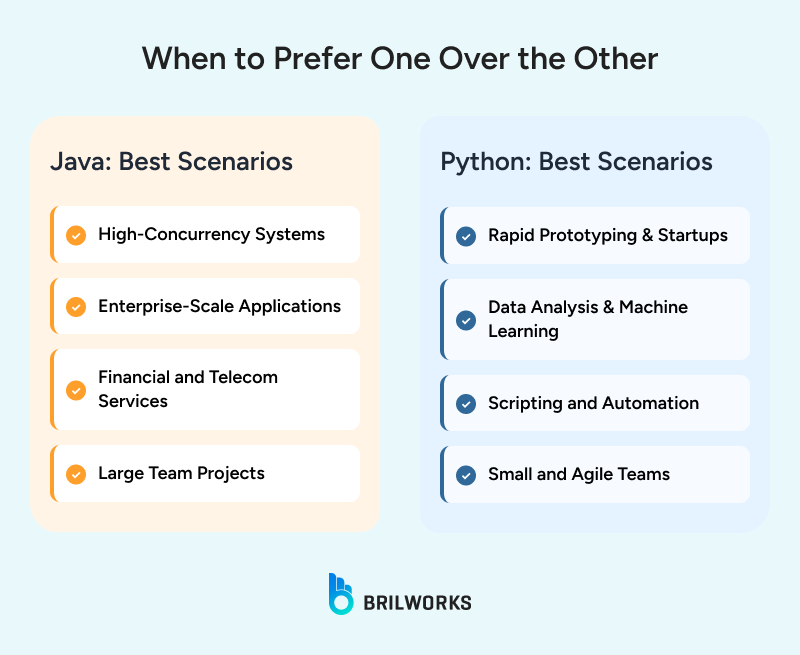
Java works well in environments that demand simultaneous processing. Its robust multithreading and JVM optimizations favor projects with heavy concurrent workloads.
For long-term, large-scale systems that need structured code and strict performance tuning, Java offers stability and mature frameworks that support complex backends.
Industries that require reliable, high-performance operations tend to benefit from Java's efficient error handling and configurable memory management.
When many developers collaborate on extensive codebases, Java’s explicit type system and build automation tools reduce ambiguity and promote consistency.
Python’s concise syntax and flexible design enable fast iteration, making it ideal for early-stage projects where time to market is crucial.
With a rich ecosystem of libraries for data science, Python is often the language of choice for projects driven by analytics and predictive modeling.
Simple to write and execute, Python excels in tasks that require quick scripting, automation, and integration with different systems without the overhead of compilation.
For projects run by small teams or individual developers, Python’s ease of deployment and minimal setup support agile development practices and quick pivots.
See Also: Nodejs vs Top backend Technologies
Both Java and Python are mature, reliable languages used across a wide range of applications. Java stands out in enterprise systems, backend-heavy platforms, and projects that need performance and long-term structure. Python fits well in environments that value speed of development, automation, and data-driven workflows.
The right choice depends on your specific needs. If you’re working on banking software, large-scale backend systems, or Android apps, Java may be the better fit. If you're focused on scripting, machine learning, or quick prototyping, Python could save time and effort.
Whether you're scaling enterprise systems or experimenting with new ideas, both languages have the depth and support to get the job done. If you're planning a project and need help choosing the right tech stack, our team can guide you with real-world experience in Java development and Python solutions.
It depends on the use case. Java is better for large-scale, performance-critical systems. Python is better for rapid development and tasks like scripting or data science.
Both languages continue to grow. Python leads in fields like AI and data, while Java remains strong in enterprise and backend systems. Neither is going away.
Python is easier for beginners due to its simple syntax. Java has more structure, which helps in understanding core programming concepts early.
Yes, Java can be used in AI, especially in production-grade applications. However, Python dominates the AI ecosystem due to its extensive libraries and active community.
The biggest difference is in syntax and performance. Java is statically typed and faster, while Python is dynamically typed and easier to write and debug.
Get In Touch
Contact us for your software development requirements
Get In Touch
Contact us for your software development requirements